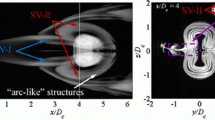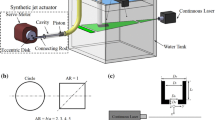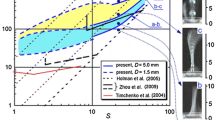Abstract
The characteristics of a novel axi-symmetrical synthetic jet in quiescent environment is investigated with laser-induced fluorescence flow visualization technique. It is found that the trajectory of vortex ring is not only related to the dimensionless stroke length, but also the suction duty cycle factor. For the case of fixed dimensionless stroke length, the diameter of vortex ring tends to become smaller in the downstream direction with the increase of suction duty cycle factor.
Graphical Abstract

Similar content being viewed by others
Avoid common mistakes on your manuscript.
1 Introduction
Synthetic jet, also known as zero net mass flux jet, was proposed in 1950 (Ingard and Labate 1950), and it was introduced into the laboratory in 1993 as an active flow control technology (Wiltse and Glezer 1993). It has attracted more and more attention, and now becomes one of the most popular flow control methods in engineering application.
Synthetic jet is governed by two independent parameters: dimensionless stroke length L and jet Reynolds number Re U0. L describes the distance of the fluid being pushed out from the orifice by the synthetic jet actuator. It was proposed that L determines the distance that vortex leaves from the actuator orifice in one actuator cycle (Smith and Glezer 1998). It was found that the vortex trajectories at different Reynolds numbers almost coincide on the same curve when they are nondimensionalized with L. When the Reynolds number is fixed, the distance that vortex leaves from the actuator orifice becomes large with L. Besides, the total circulation of vortex ring at the end of blowing duration increases with L for L ≤ 4. However, for L > 4, the circulation of primary vortex ring keeps constant and a secondary vortex structures is formed (Zhong et al. 2007). When L is fixed, the vorticity of vortex ring increases with the jet Reynolds number Re U0 (Shuster and Smith 2007). With the increase of Re U0, the jet flow changes gradually from laminar to turbulent.
A hybrid-synthetic jet was proposed to promote the efficiency of the synthetic jet flow control (Tesar et al. 2007), which is essentially not a zero net mass flux jet. Furthermore, an efficient synthetic jet excitation signal was suggested to improve the synthetic jet flow control efficiency (Zhang and Wang 2007). In Fig. 1, T 1 respects the blowing duration, and T 2 respects the suction duration. It has been concluded that the efficiency of the synthetic jet can be improved with the variation of T 2–T 1 ratio, which is named as the suction duty cycle factor k = T 2/T 1. The numerical simulation (Zhang and Wang 2007) showed that the strength of the vortex is stronger and the synthetic jet is more efficient when the suction duty cycle factor k > 1. It was also proved by two-dimensional slot synthetic jet experiment (Wang et al.2010), orifice synthetic jet experiment (Shan and Wang 2010) and circular cylinder vortex-synchronization control experiment with a synthetic jet (Feng et al. 2010). Different from the previous investigations, which focused on the evolution of synthetic vortex ring with large Reynolds number (Zhang and Wang 2007; Wang et al. 2010), this paper will concentrated on the study of the evolution of synthetic jet with small Reynolds number in quiescent environment.
2 Experimental facilities and techniques
The experiment was conducted in the circulating water channel of Institute of Fluid Mechanics, Beijing University of Aeronautics and Astronautics. The test section of the channel is 4800 mm long with the cross-section of 600 mm × 600 mm. The piston type synthetic jet actuator used in the experiment is independently developed, as shown in Fig. 2a. Personnel computer and programmable controller are used to control the servo motor for uniform circular motion (for k = 1) and variable speed circular motion (for k ≠ 1). The eccentric wheel is a crank mechanism, its circular motion can transform to back and forth movement of a piston in a cavity. This cavity is connected with the orifice in the flat plate, therefore, a synthetic jet is issued from this orifice.
Laser-induced fluorescence (LIF) flow visualization technique is used in the experiment, and the dye is rhodamine 6G (Rhodamine 6G, molecular formula C28H30N2O3). The light source is semiconductor laser with power of 5 W and laser wavelength of 532 nm. Images are recorded by a CMOS camera with a resolution of 2048 × 1280 pixels and data acquisition frequency of 60 Hz. The layout of experimental installation is shown in Fig. 2b for the orifice diameter of 20 mm.
3 Experimental results and analysis
According to the “slug” model (Smith and Glezer 1998), the basic characteristics of the synthetic jet may be governed by two dimensionless parameters, dimensionless stroke length L and jet Reynolds number Re U0, respectively, which can be calculated as follows:
The time-averaged blowing velocity in the whole period is
and the instantaneous velocity at orifice is
If T 1 respects the blowing duration and T 2 respects the suction duration in the non-sinusoidal signal case, the instantaneous velocity at orifice in the blowing duration is
and the time-averaged blowing velocity in the whole period is
which is the same as that for k = 1.
In the above formulas, f is the excitation frequency, Δ is the eccentricity of eccentric disk, R is the inner diameter of the jet tube, D is the orifice diameter, T is the excitation cycle and ν is the kinematic viscosity coefficient of water. In this experiment, R = 29 mm, D = 10 and 20 mm, T = 2 and 4 s, f = 0.5 and 0.25 Hz. Table 1 shows the value of Δ and L in this investigation.
3.1 Flow structure evolution for k = 1
Figure 3 shows the flow visualization results at different Reynolds numbers for k = 1 (i.e., standard sinusoidal signal). Each row from left to right is at the end time of first, second and fourth cycle, respectively. Moreover, each column from top to bottom is L = 0.92, 1.39 and 1.85 Re U0 = 46, 70 and 92.5, respectively. It can be seen from Fig. 3 that the distance of vortex ring moving downstream the orifice increases with the increase of Reynolds number for k = 1.
Based on the flow visualization results, the trajectory of the vortex ring is estimated with the method shown in Fig. 4. The distance between the location of vortex ring and the orifice is L c (L c = L 1 + L 2/2) and the radius of vortex ring is r (r = x 1 + x 2/2). L 1, L 2, x 1 and x 2 are read from the digital images with the error of ±2 pixels. One pixel is equal to about 0.0516 mm.
Figure 5 shows the vortex ring trajectories of synthetic jets at different Reynolds numbers, as well as different L, in two periods for k = 1. We can see from Fig. 5 that the vortex ring trajectories L c vary with time at different Reynolds numbers: the distance between the location of vortex ring and the orifice increases with L. If L c is normalized with L 0, the vortex ring trajectories are almost overlapping into one curve. It can be concluded for k = 1 that the vortex ring trajectories are mainly associated with dimensionless stroke length L. This is in agreement with the previous result (Smith and Glezer 1998).
3.2 The influence of k on vortex ring trajectory
The flow visualization results at different suction duty cycle factor k are shown in Fig. 6 for L = 1.16, Re U0 = 58. Each row from left to right is at the end time of first, second and fourth period, respectively, and each column from top to bottom is for the case of k = 1, 2, 3 and 4, respectively. It can be found that the distance between the location of vortex ring and the orifice increases with k at the same instance.
Figure 7 shows the vortex ring trajectories at different k in two periods for L = 1.16 (Fig. 7a) and L = 1.39 (Fig. 7b), respectively. It can be seen that L c increases with k. Moreover, if L c is normalized by L 0, the vortex ring trajectories can not be overlapped into one curve. Obviously, when k ≠ 1, the vortex ring trajectories are associated with not only dimensionless stroke length L, but also the suction duty cycle factor k.
Figure 8 shows the vortex ring trajectories normalized by kL 0 for L = 1.16 and L = 1.39. In comparison with Fig. 7b, the trajectories at different k are closer to each other, but they still can not overlap into one curve. It is believed that the suction duty cycle factor k plays an important role in the evolution of vortex structure downstream the orifice, which is consistent with the numerical simulation (Zhang and Wang 2007). The actual effective Reynolds number increases with k, and the effect of entrainment in the suction duration becomes weaker, therefore leading the vortex ring to move farther.
The influence of k on vortex ring trajectory can be divided into two time durations: the blowing duration and the suction duration. Figure 9a shows the results at the end time of the blowing duration of different k. It can be seen clearly that the locations of the vortex rings are almost the same. But, at the end time of the suction duration, the locations of the vortex rings are varied with k. Obviously, the location of vortex ring formed at the blowing duration is not affected by k. However, at the suction duration, k has a significant impact on the position of the vortex ring. This means that the distance between the location of vortex ring and the orifice at the end time of suction duration (i.e., the end time of the entire cycle) increases with k. It is the possible reason that for fixed value of L, the volume of the fluid discharged from the orifice is constant. However, the increase of k makes the time of blowing duration shorter and the blowing velocity faster. Meanwhile, the suction time becomes longer, that leads to a reduction of the reverse flow velocity, and further promotes the velocity of the forward movement of the vortex ring.
3.3 The influence of k on the diameter of the vortex ring
As can be seen from Fig. 10, if the dimensionless stroke length L is constant (L = 1.39, Re U0 = 69), the diameter of vortex rings varies with k. For k = 1, a stable vortex ring is hard to form, and the flow structure is almost sucked back to orifice or accumulate in the near orifice region and slowly move downstream by the action of the blowing duration of the following cycle. For k = 2, some of the structure is sucked back to orifice and the remaining part slowly move downstream. For k = 3, a stable vortex ring is formed: little part of it is sucked back and there is an elongation at the flow direction when it moves downstream freely. For k = 5, the influence of the suction duration on vortex ring becomes weak, and there is a large gap between adjacent vortex rings.
Figure 11 shows the radius variation e of the vortex rings in three periods for L = 1.39, Re U0 = 69 There is a significant contraction in the first period, which may be caused by the suction duration. Vortex ring has a tendency to expand for k = 2 and 3, respectively, this phenomenon can also be found in Fig. 10d. It may be attributed to the small convection speed between adjacent vortex rings for k = 2 and 3, while the convection speed becomes larger for k = 5. This is a very interesting flow phenomena and more detailed measurement are needed in the future to reveal the mechanism.
4 Conclusions
For the case of suction duty cycle factor k = 1, the same as the standard sinusoidal signal, the vortex ring trajectory is associated with dimensionless stroke length L. For k > 1, the distance between the location of vortex ring and the orifice is not only related to L, but also positively correlated with k. The increase of k means that the vortex ring is accelerated, therefore, the vortex ring could move farther away from the orifice.
The suction duty circle factor k influences the diameter of the vortex ring. When the dimensionless stroke length L is constant, the shapes of vortex rings vary significantly with k. Moreover, the diameter of vortex ring tends to become smaller downstream with the increase of k, however, this mechanism is still unknown.
References
Feng LH, Wang JJ, Chong P (2010) Effect of novel synthetic jet on wake vortex shedding modes of a circular cylinder. J Fluids Struct 26:900–917
Ingard U, Labate S (1950) Acoustic circulation effects and the nonlinear impedance of orifices. J Acoust Soc Am 22:211–218
Shan RQ, Wang JJ (2010) Experimental studies of the influence of parameters on axisymmetric synthetic jets. Sens Actuators A 157:107–112
Shuster JM, Smith DR (2007) Experimental study of the formation and scaling of a round synthetic jet. Phys Fluids 19(4):045109
Smith BL, Glezer A (1998) The formation and evolution of synthetic jets. Phys Fluids 10(9):2281–2297
Tesar V, Travnıcek Z, Kordık J, Randa Z (2007) Experimental investigation of a fluidic actuator generating hybrid-synthetic jets. Sens Actuators A 138:213–220
Wang JJ, Shan RQ, Zhang C, Feng LH (2010) Experimental investigation of a novel two-dimensional synthetic jet. Eur J Mech B Fluids 29:342–350
Wiltse J, Glezer A (1993) Manipulation of free shear flows using piezoelectric actuators. J Fluid Mech 249:261–285
Zhang PF, Wang JJ (2007) Novel signal wave pattern to generate more efficient synthetic jet. AIAA J 45(5):1058–1065
Zhong S, Jabbal M, Tang H et al (2007) Toward the design of synthetic jet actuators for full scale flight conditions, part 1: the fluid mechanics of synthetic jet actuators. Flow Turbul Combust 78:283–307
Author information
Authors and Affiliations
Corresponding author
Rights and permissions
About this article
Cite this article
Duan, T., Wang, J. Experimental investigation on the evolution of axi-symmetrical synthetic jet. J Vis 19, 351–358 (2016). https://doi.org/10.1007/s12650-015-0322-x
Received:
Revised:
Accepted:
Published:
Issue Date:
DOI: https://doi.org/10.1007/s12650-015-0322-x















